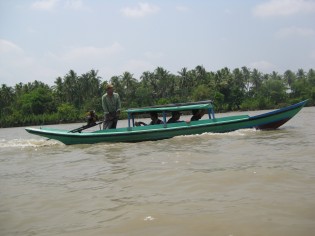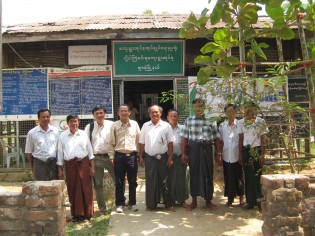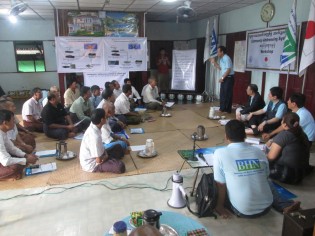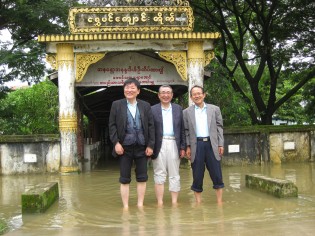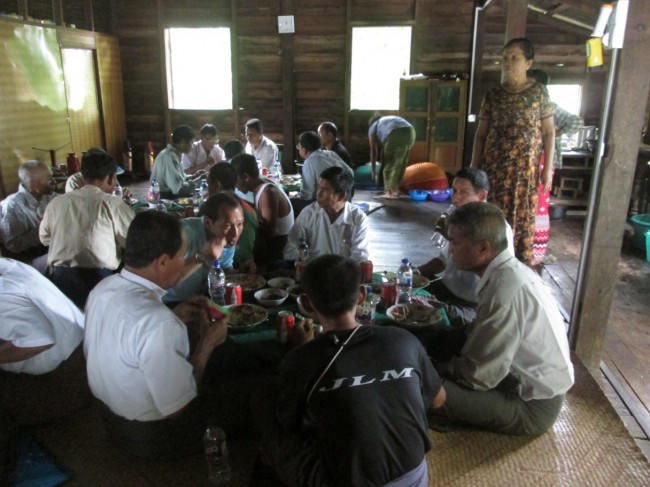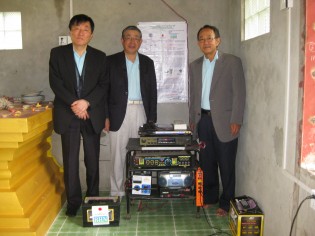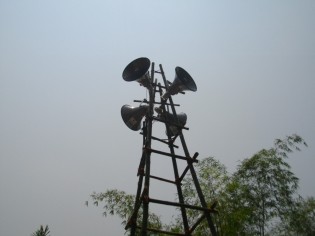Community Life Improvement Project Utilizing Community Addressing System in the Ayeyarwady River Delta
2014.9.3 Wed 16:55
●The first workshop of our project held in Myanmar
Community Addressing Systems (CA systems) have been installed in the delta area in southern Myanmar where no commercial electricity, water supply nor telephone is available.
We hope that these systems would help the local people not only to cope with emergency situations such as the arrival of cyclones but also to improve their daily life.
Normally, this kind of a project ends at the completion of system installation. However, we thought that this is not enough in order for the systems to be utilized and maintained by the villagers for years to come.
Therefore, instead of holding one-sided training sessions, we asked each village to set up a “CA system Operation Committee” and then we organized a training workshop for the Committee members.
The goal of the workshop is to let the Committee members learn how to maintain and operate the system and understand its function.
The workshop will train the participants on effective use of radio, other broadcasting items, content and timing of?broadcasted messages, etc. in both everyday life as well as in emergencies.
We will also illustrate efficient usage (techniques, know-how) of the system with examples while maintaining a bilateral exchange of opinions and suggestions.
A meeting for Workshop preparation was held in Myanmar at the beginning of April, 2014.
Project Manager in BHN Myanmar office and two members from BHN head office (Tokyo) participated in the meeting.
We were planning to start the workshops as soon as possible, but the timing of the workshops became an important issue.
This is because, unlike the rainy season in Japan, it rains heavily and continuously along with strong winds during the rainy season in Myanmar, which is typically between middle of May and middle of October.
This year they had unusual heavy rains, so much so that it would be difficult and dangerous for all involved to get to the workshop venue by boat as waters would be high and winds would be strong.
To make matters worse, it seemed difficult to get full participation from the village members because they are?usually very busy planting rice and tending to rice fields in this season.
So we rescheduled the actual workshops to the dry season (November to December) in view of safety and availability of participants so that our training goals can be fulfilled.
However, to evaluate the relevance of the scheme and the materials for the workshop, we decided to hold a trial workshop with about twenty participants on 16th of July, 2013.
We kept it limited to 5 villages only (in Kyauktan township of Yangon district suburbs) where it was thought to be less influenced by the rainy season.
At the meeting site, we raised flags of The Myanmar Chamber of Commerce (UMFCCI), Japan, and BHN Association so that the workshop participants will be reminded of Japan’s contribution to the system.
Although we had hoped to escape from the influence of the rainy season, there was a challenge in attending this workshop due to torrential rains and strong winds that hit the area. Fortunately, the rain stopped on the workshop day and everyone got to the venue (a monastery) safely.
However, due to torrential rains in the region, the ground floor of the building was completely flooded and as a result participants had to roll their pants up and wade through knee deep water to get to the second floor.
At the end of this trial workshop, we sought opinions about it from the participants by requesting them to fill a questionnaire to understand their impression of the workshop.
Many participants thanked us for providing CA systems in an area where no commercial electricity is supplied. Afterwards, we exchanged suggestions and opinions over lunch.
We agreed that it was important to receive and understand the response of the participants.
We understood through the answers to the questionnaire that participants appreciated us holding the workshop and that the contents were relevant and significant to them. Thus, we concluded that our training goals were reached.
The above trial workshop was held in a monastery.
However, we are considering holding the next one in a big hall in a township (county capital) and decided that the optimal size of a workshop would be to include 10-15 villages (three persons per village).
The first phase of our project started on 24th of September, 2013 and finished on 23rd of July, 2014.
In order to continue with the remaining workshops that were rescheduled as well as to install CA systems in additional villages, we have applied for Grant Assistance for Japanese NGO Project from the Ministry of Foreign Affairs for the second phase of the project starting in September, 2014.
NGO cooperation project in Myanmar
Eiichi Watanabe, Counselor

